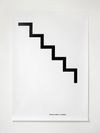Christian Andersen, Frederiksholms Kanal 28A, 1220 Copenhagen K, +45 2537 4101, info@christianandersen.net
Images
Press release
Dispersion, disruption and breakdown – these are some of the ways to describe the visual operations at play in Anders Clausen’s new work. Here we find text and image distributed on vinyl sheets, two kinds of language wrenched from their source, lawlessly occupying space and form anew, where the semi-gloss of the white surface pushes and pulls things in and out of focus, the ‘blanks’ between and around things, rally to efface them. The letters, words, half sentences and graphic marks that make up these derailed, image-text compositions culled from the Internet and from word processing software are not code and nor are they concrete poetry, but rather something like ensemble portraits, not a portrait of the artist or anyone in particular, but more like portraits of the act of doing, or more precisely, the act of creating or producing.
These composite portraits of production seek to pick apart but not to regroup their elements into a coherent whole. By deterritorialising language and image, the works persist in and through a kind of secondary abstraction coercing visual syntax into semi-intelligibility within a unstable horizon of interpretation. These tensions are made manifest through the choice of source material, surface, typography, language, colour and the reversals between digital and analogue materiality. With the works’ minimalist appearance and stoic expressionism verging on the absurd, what happens when an extract from a love poem produced entirely by algorithms, lyrics from a Kraftwerk track or a line from Herman Melville’s 1853 short story ‘Bartleby, the Scrivener’ (‘I would prefer not to’) is coupled with computer software data controls (‘This file is not available’) and their attendant box frames, zigzags and diacritical marks (the tilde or swoosh)? What does this collapse between man, machine, control, love, pop culture and emancipatory politics suggest about work and creativity? And what does is say about the role of the artist?
Clausen’s large-scale works on PVC are compound images of multiple flows of data captured, downloaded and reformatted into rebus-like configurations with their truncated sentences, typographic ‘mistakes’ and awkward image-text collisions. They create a kind of visual stutter, a ‘disabled’ language that is an effect of their source’s orphaned status, such and such generation of Internet matter with its own history, its own materiality, set against the disciplinary interface enclosures or micro feedback loops of correction, diversion, merging and tracking. To complicate these works further, Clausen, after printing the images, returns to them to physically excise or erase some areas and to build up others with vinyl adhesives or paint. These procedures produce less the surface effects of a painting than a kind of self-vandalism, from (self) corrupted data to bastardised surfaces, forming another structural tension as a portrait of the ‘work’ of the work, the act of production itself.
David Bussel, Berlin 2013









